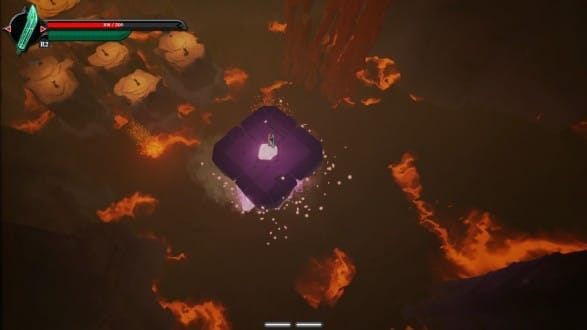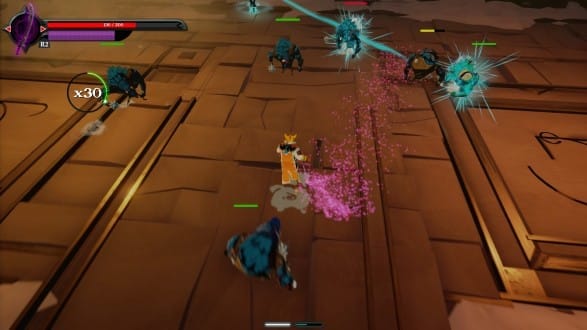Player choice has been something in games since the early days. Usually it's not much more than choosing to be good or evil, or who to save and who dies. Stories: The Path of Destinies is looking to try to change things up a bit. Taking some hints from various games, Stories tries to present players with choices that change the entire story. Yet can this game do it?
Stories puts you in the role of fox pirate Reynardo. He gives up his buccaneering ways at the request of his dying mother, but his peaceful life doesn't last long when the king goes mad and begins to invade every nearby village with his crow army. He becomes very interested in a book that, thanks to a series of events, falls into Reynardo's hands. This book allows its owner to see into the future and plan out his next moves. Sure enough, Reynardo begins to use the book to figure out how to defeat the empire.

It's in the exploration of these various futures that Stories' plot really kicks off. Each of the game's "stories" starts with one of three choices. Each of those choices leads to a different level where, at the end, you are presented with another choice. You'll keep advancing through choices that lead to different levels until you get to the end of your current story, often ending in Reynardo discovering something big before he's killed. Each time you finish a story you have a chance to discover one of the four truths, these being the four most important plot points in the game that will help Reynardo discover a path that doesn't get him killed.
It's actually kind of intriguing, getting to see how the same story can vastly change depending on what Reynardo decides to go after. One story saw me destroy the universe, while another had me attempt to run off with Reynardo's girlfriend to avoid the war. It's nice seeing a game toy with the whole "choices matter" concept, having them both matter and not matter at the same time. However, once you've gone through a few stories, the game begins to feel repetitive. Each story is five chapters long, which takes about an hour and a half each, and if the only thing you're changing is your choice in the fourth chapter, then you have to play though the same content all over again. Even if you're making different choices, you still risk seeing the same content, as the game only has about 10 locations to alternate between, and you'll have to go through them again and again for different reasons.

Tying the game together is the narrator. Taking hints from games like Bastion, Stories has a narrator that helps give context to the world while making fun of Reynardo's actions. Smash a bunch of crates, and he'll tease you for it. Enter an encounter and you'll hear some taunts. Notably, every character is also voiced by the narrator trying to do different voices. It makes the game feel like a story told by a father almost, which is a great way to add to the whole feeling of reading a book that the game is trying to convey.
Of course, you actually do have to smash those crates and fight those crows. To do this, you'll be using a simple system reminiscent of the Arkham series. You have one button to attack, and Reynardo will jump between enemies to slash at them with his sword. You also counter using the same button, though you have to actually point the analog stick at the attacking enemy as well. These two moves can get you through the majority of encounters in the game, and it suffers from the same repetition as the story elements at times.
You have a few special techniques, but most of them never feel necessary. The most important is that you can throw crows into each other. At first, it's the only way to get shield grunts to drop their shields, but later you get alternate options that make it feel less important. You can dash to avoid attacks, and can even dash through enemies to do a little damage, but I found countering to be more useful. A hook allows you to pull enemies closer to you, but when Reynardo just jumps to enemies anyway there doesn't seem to be much point in this.
Of all of Reynardo's skills, his sword abilities are probably the most vital. There are four different swords in the game, and each one has a unique skill used by holding down a button while attacking. I found the most useful sword ability to be the one that drained health when you attacked, allowing you to heal in combat. Others allowed me to light enemies on fire to deal damage over time, freeze enemies in place, and gain massive buffs to my attack speed. These abilities are a good way to modify combat, but they ultimately never feel more than a little necessary.

One reason the combat feels so repetitive is the lack of any real enemy variety. There's a grand total of four enemy types in the game (technically five, but one only appears in stealth sections) and three of them can be defeated by just mashing square. Shield grunts are the only one that require tactics of any kind, at least until you find a gem that allows you to knock their shields away with normal attacks, which just turns them into regular enemies. There are spellcasters that will either use fireballs or buff other enemies, but they're not particularly different in how you'll fight them either. The occasional stealth section is a nice break, but it's usually just a simple "stay out of the glowing eyesight cone" sort of thing.
Reynardo has a pretty big skill tree with quite a few interesting options on it. Taking one path allows him to put the game into slow motion whenever a perfectly timed block is executed, another allows him to jump to enemies from even greater distances. Exploring the environments will let players discover chests that contain crafting ingredients for sword upgrades and gems that grant passive buffs. It's nothing that other games haven't done before, and it all works competently enough. In the end, I didn't think there was enough to upgrade. I had all the swords maxed out and found all the gems after just a couple of stories. On the other hand, leveling up is so slow that I had only reached the second tier of skills at that same point.

Outside of combat you'll basically just be running through the levels. Levels are well-made with multiple ways through them, and you can use your swords to open up special doors to get even more ways to go through. Sometimes you'll have to use your hook to move between floating platforms, but this isn't really much other than looking cool. There is a rare puzzle, but it's often little more than flipping a few switches while avoiding fireballs.
Sadly, Stories is a glitchy game. The worst offender came from a snowy mountain level that I couldn't seem to manage a pass through without something messing up. More than once I fell halfway into the level, getting stuck in the ground and unable to move. Another time, I found myself on an area of the level that wouldn't load, meaning I had to try to figure out where I was going on an invisible pathway. While this level was the worst offender, some others had problems too. Once I paused the game only to find that it never paused, just brought the menu up. I came back to find myself at a game over screen thanks to the crows slaughtering me as I stood still. I also found it basically a 50/50 chance if the "skip cutscene" button would work, something that became annoying when I had to re-watch the same cutscenes over and over for slightly different story lines.
Stories: The Path of Destines has an interesting story to tell and tells it in a entertainingly unique way. Yet I wish there was more to the game than there actually is. It needed more levels to feel less repetitive, more enemies and abilities to spice up the combat, more things to do outside of combat, and a little more time spent smoothing over the glitches. Stories is a decent tale, but it doesn't quite hit the heights it could have.
Stories: The Path of Destinies was reviewed on a PlayStation 4 using a code provided by the developer. The game is also available on Steam.
Review Summary
Have a tip, or want to point out something we missed? Leave a Comment or e-mail us at tips@techraptor.net













